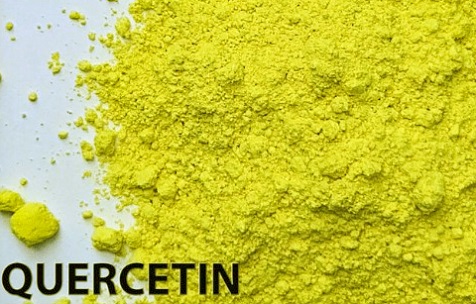Nikhil Prasad Fact checked by:Thailand Medical News Team Dec 13, 2024 1 year, 1 week, 4 days, 18 hours, 31 minutes ago
Medical News: Non-alcoholic fatty liver disease (NAFLD) is emerging as a significant global health challenge. Characterized by the accumulation of excess fat in the liver, it affects approximately 30% of the world's population and is projected to increase further due to sedentary lifestyles and unhealthy diets. In its more severe form, non-alcoholic steatohepatitis (NASH), it can lead to irreversible liver damage, cirrhosis, or even liver cancer.
 Quercetin as a Potential Treatment for Fatty Liver Disease
Quercetin as a Potential Treatment for Fatty Liver Disease
Researchers from the National and Kapodistrian University of Athens, Laikon General Hospital, and Democritus University of Thrace in Greece, conducted an experimental study to explore the potential therapeutic effects of quercetin - a natural flavonoid known for its antioxidant and anti-inflammatory properties - on NAFLD. This
Medical News report delves into their findings and discusses the potential of quercetin as a treatment option for this pervasive metabolic condition.
The Experimental Approach
The study involved 47 male mice, divided into groups to examine the effects of quercetin at low (10 mg/kg) and high (50 mg/kg) doses. These animals were initially fed a high-fat diet (HFD) for 12 weeks to induce NAFLD. Following this, quercetin was administered for an additional four weeks. To improve its bioavailability, quercetin was delivered in a complexed form with hydroxypropyl-β-cyclodextrin (HP-β-CD).
Histological assessments of liver tissue were conducted to evaluate NAFLD severity. The researchers utilized the NAFLD Activity Score (NAS), which measures three critical components: steatosis, inflammation, and hepatocyte ballooning. Additionally, they analyzed the role of key autophagy-related proteins such as Beclin1, p62, and LC3.
Key Study Findings
The study revealed that quercetin administration significantly reduced NAS compared to control groups. The reduction was particularly evident in components associated with steatosis and inflammation. This improvement underscores quercetin’s potential in mitigating fat accumulation and liver inflammation - two hallmarks of NAFLD progression.
Effects on Autophagy
Autophagy is a cellular process critical for maintaining liver health. It regulates lipid metabolism and prevents the accumulation of harmful substances within liver cells. NAFLD often impairs this process, leading to further fat accumulation and liver damage. The study observed that quercetin treatment enhanced the expression of autophagy markers such as LC3 and p62. This suggests improved autophagic activity, which could contribute to lipid degradation and reduced liver fat.
Interestingly, while Beclin1 expression - a key autophagy initiator - remained consistent across all groups, significant differences in downstream markers like LC3 and p62 were observed. This highlights quercetin’s role in enhancing specific stages of the autophagy process rather than initiating it.
Dose-Dependent
Observations
Both low and high doses of quercetin showed beneficial effects, but the study did not establish a clear dose-dependent relationship. This indicates that while higher doses may not always amplify the therapeutic benefits, they remain effective in addressing NAFLD’s pathological features.
Reduction in Steatohepatitis Prevalence
The control group, which did not receive quercetin, exhibited a higher prevalence of steatohepatitis - the inflammatory stage of NAFLD. In contrast, quercetin-treated groups showed a marked reduction in this progression. These findings align with previous research demonstrating quercetin’s anti-inflammatory properties, which may inhibit pathways leading to fibrosis and advanced liver damage.
Implications for Human Health
Quercetin’s therapeutic effects in this study reinforce its potential as a natural treatment for NAFLD. By improving autophagic flux and reducing liver fat and inflammation, it addresses critical aspects of the disease’s progression. Furthermore, the use of HP-β-CD complexes to enhance quercetin’s bioavailability is a promising strategy for overcoming its solubility limitations, potentially making it more effective for clinical applications.
However, it is essential to note that translating these findings to human health requires further investigation. The study focused on a mouse model, and human trials are needed to validate the efficacy, safety, and optimal dosing of quercetin for NAFLD treatment.
Conclusions
This study highlights quercetin’s potential as a therapeutic agent for NAFLD by showcasing its ability to reduce liver fat, inflammation, and steatohepatitis prevalence. Its role in enhancing autophagic processes is particularly noteworthy, as it addresses one of the underlying mechanisms of liver damage in NAFLD.
While these findings are promising, further research is necessary to understand the precise molecular pathways influenced by quercetin and to establish its efficacy in humans. Future studies should also explore its interactions with existing treatments and its long-term safety profile. The consistent expression of Beclin1 and the modulation of p62 and LC3 proteins indicate that quercetin’s benefits are linked to improvements in autophagic activity rather than initiation. This nuanced understanding of its mechanism can guide the development of more targeted therapies for NAFLD.
The study findings were published in the peer-reviewed journal: Nutrients.
https://www.mdpi.com/2072-6643/16/24/4282
For the latest on Liver Diseases, keep on logging to Thailand
Medical News.
Read Also:
https://www.thailandmedical.news/news/lycorine-s-potential-as-a-treatment-for-liver-disease
https://www.thailandmedical.news/news/tryptophan-metabolites-and-their-impact-on-liver-disease-progression
